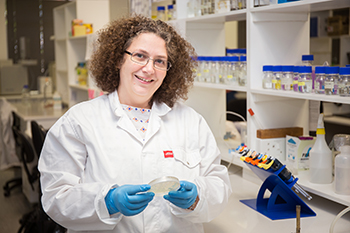
Dr Trudi O’Neill, Senior lecturer in the Department of
Microbial, Biochemical and Food Biotechnology.
Photo: Anja Aucamp
Dr Trudi O’Neill, Senior lecturer in the Department of Microbial, Biochemical and Food Biotechnology, is conducting research on rotavirus vaccines.
Dr O’Neill was inspired to conduct research on this issue through her fascination with the virus. “The biology of rotaviruses, especially the genome structure and the virus’ interaction with the host, is fascinating.”
“In fact, it is estimated that, globally, ALL children will be infected with rotavirus before the age of five, irrespective of their socio-economic standing. However, infants and young children in poor countries are more vulnerable due to inadequate healthcare. The WHO estimates that approximately 215 000 deaths occur each year. This roughly equates to eight Airbus A380 planes, the largest commercial carrier with a capacity of approximately 500 seats, filled with only children under the age of five, crashing each week of every year.”
Alternative to expensive medicines
“Currently, there are two vaccines that have been licensed for global use. However, these vaccines are expensive and poor countries, where the need is the greatest, are struggling to introduce them sustainably. It is therefore appealing to study rotaviruses, as it is scientifically challenging, but could at the same time have an impact on child health,” Dr O’Neill said.
The main focus of Dr O’Neill’s research is to develop a more affordable vaccine that can promote child vaccination in countries/areas that cannot afford the current vaccines.
All about a different approach
When asked about the most profound finding of her research, Dr O’Neill responded: “It is not so much a finding, but rather the approach. My rotavirus research group is making use of yeast as vehicle to produce a sub-unit vaccine. These microbes are attractive, as they are relatively easy to manipulate and cheap to cultivate. Downstream production costs can therefore be reduced. The system we use was developed by my colleagues, Profs Koos Albertyn and Martie Smit, and allows for the potential use of any yeast. This enables us to screen a vast number of yeasts in order to identify the best yeast producer.”
Vaccination recently acquired a bad name in the media for its adverse side effects. As researcher, Dr O’Neill has this to say: “Vaccines save lives. By vaccinating your child, you don’t just protect your own child from a potentially deadly infection, but also other children in your community that might be too young to be vaccinated or have pre-existing health problems that prevents vaccination.”
A future without rotavirus vaccination?
Dr O’Neill believes a future without rotavirus vaccination will be a major step backwards, as the impact of rotavirus vaccines has been profound. “Studies in Mexico and Malawi actually show a reduction in deaths. A colleague in Mozambique has commented on the empty hospital beds that amazed both clinicians and scientists only one year after the introduction of the vaccine in that country. Although many parents, mostly in developed countries, don’t have to fear dehydrating diarrhoea and potential hospitalisation of their babies due to rotavirus infection anymore, such an infection could still be a death sentence in countries that have not been able to introduce the vaccine in their national vaccination programmes,” she said.